Report on Negotiation, Pitching, and RFP Skills in Business Context
VerifiedAdded on 2020/10/22
|15
|4463
|159
Report
AI Summary
This report delves into the crucial aspects of negotiation and pitching skills within a business context, using Marks and Spencer as a case study. It explores the fundamentals of negotiation, including its rationale, process, and evaluation, as well as the roles of stakeholders. The report then examines the Request for Proposal (RFP) process, outlining required documentation and the consequences of breaching agreements. It further analyzes competitive tendering and contract processes, offering recommendations for tender completion. The report also covers the pitching process, various methods for successful pitches, and the development of dynamic pitch outcomes. Finally, it discusses post-pitch obligations, potential issues, and the evaluation of pitch outcomes for risk management. Overall, the report provides a comprehensive overview of these essential business development skills and their practical application.
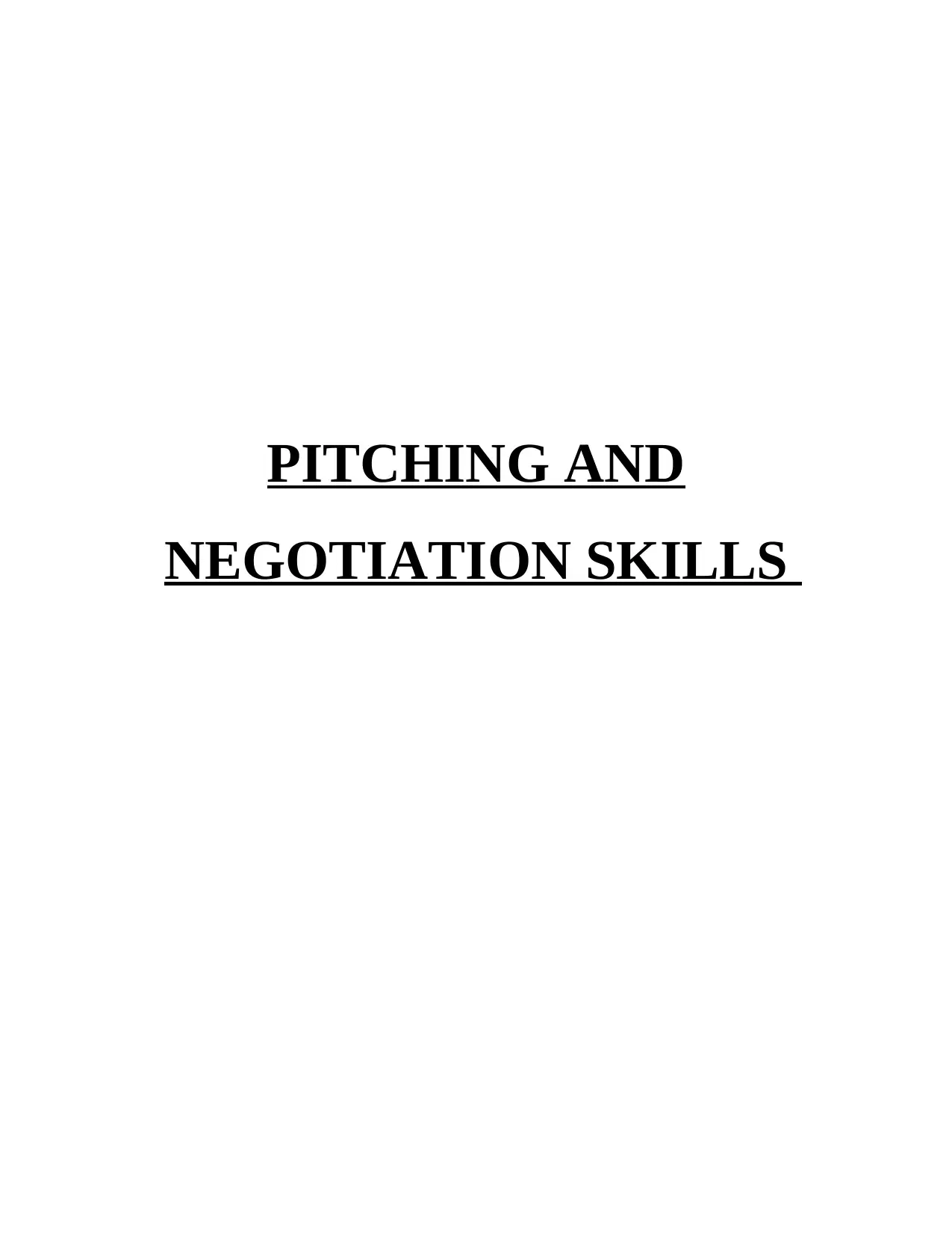
PITCHING AND
NEGOTIATION SKILLS
NEGOTIATION SKILLS
Paraphrase This Document
Need a fresh take? Get an instant paraphrase of this document with our AI Paraphraser
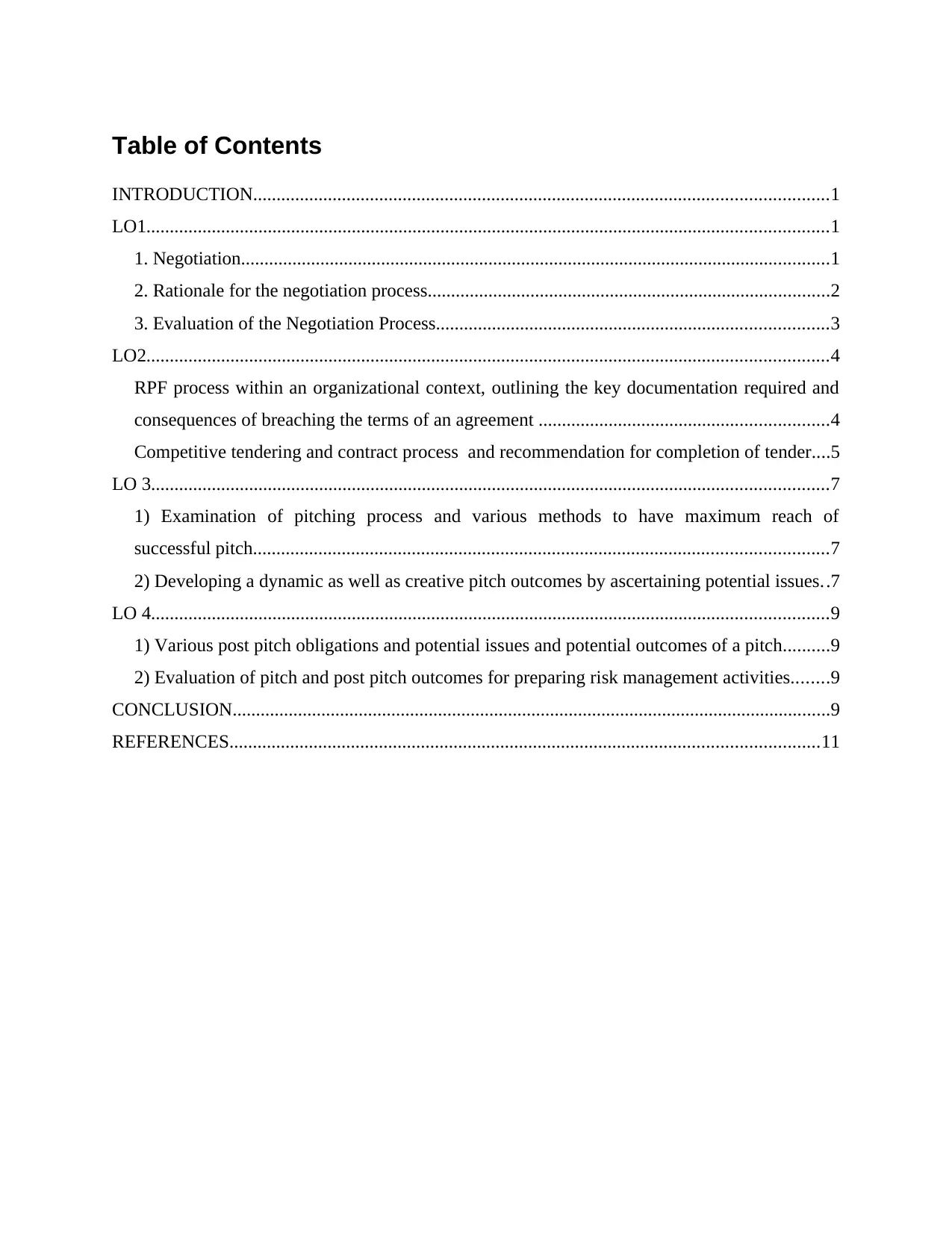
Table of Contents
INTRODUCTION...........................................................................................................................1
LO1..................................................................................................................................................1
1. Negotiation..............................................................................................................................1
2. Rationale for the negotiation process......................................................................................2
3. Evaluation of the Negotiation Process....................................................................................3
LO2..................................................................................................................................................4
RPF process within an organizational context, outlining the key documentation required and
consequences of breaching the terms of an agreement ..............................................................4
Competitive tendering and contract process and recommendation for completion of tender....5
LO 3.................................................................................................................................................7
1) Examination of pitching process and various methods to have maximum reach of
successful pitch...........................................................................................................................7
2) Developing a dynamic as well as creative pitch outcomes by ascertaining potential issues..7
LO 4.................................................................................................................................................9
1) Various post pitch obligations and potential issues and potential outcomes of a pitch..........9
2) Evaluation of pitch and post pitch outcomes for preparing risk management activities........9
CONCLUSION................................................................................................................................9
REFERENCES..............................................................................................................................11
INTRODUCTION...........................................................................................................................1
LO1..................................................................................................................................................1
1. Negotiation..............................................................................................................................1
2. Rationale for the negotiation process......................................................................................2
3. Evaluation of the Negotiation Process....................................................................................3
LO2..................................................................................................................................................4
RPF process within an organizational context, outlining the key documentation required and
consequences of breaching the terms of an agreement ..............................................................4
Competitive tendering and contract process and recommendation for completion of tender....5
LO 3.................................................................................................................................................7
1) Examination of pitching process and various methods to have maximum reach of
successful pitch...........................................................................................................................7
2) Developing a dynamic as well as creative pitch outcomes by ascertaining potential issues..7
LO 4.................................................................................................................................................9
1) Various post pitch obligations and potential issues and potential outcomes of a pitch..........9
2) Evaluation of pitch and post pitch outcomes for preparing risk management activities........9
CONCLUSION................................................................................................................................9
REFERENCES..............................................................................................................................11
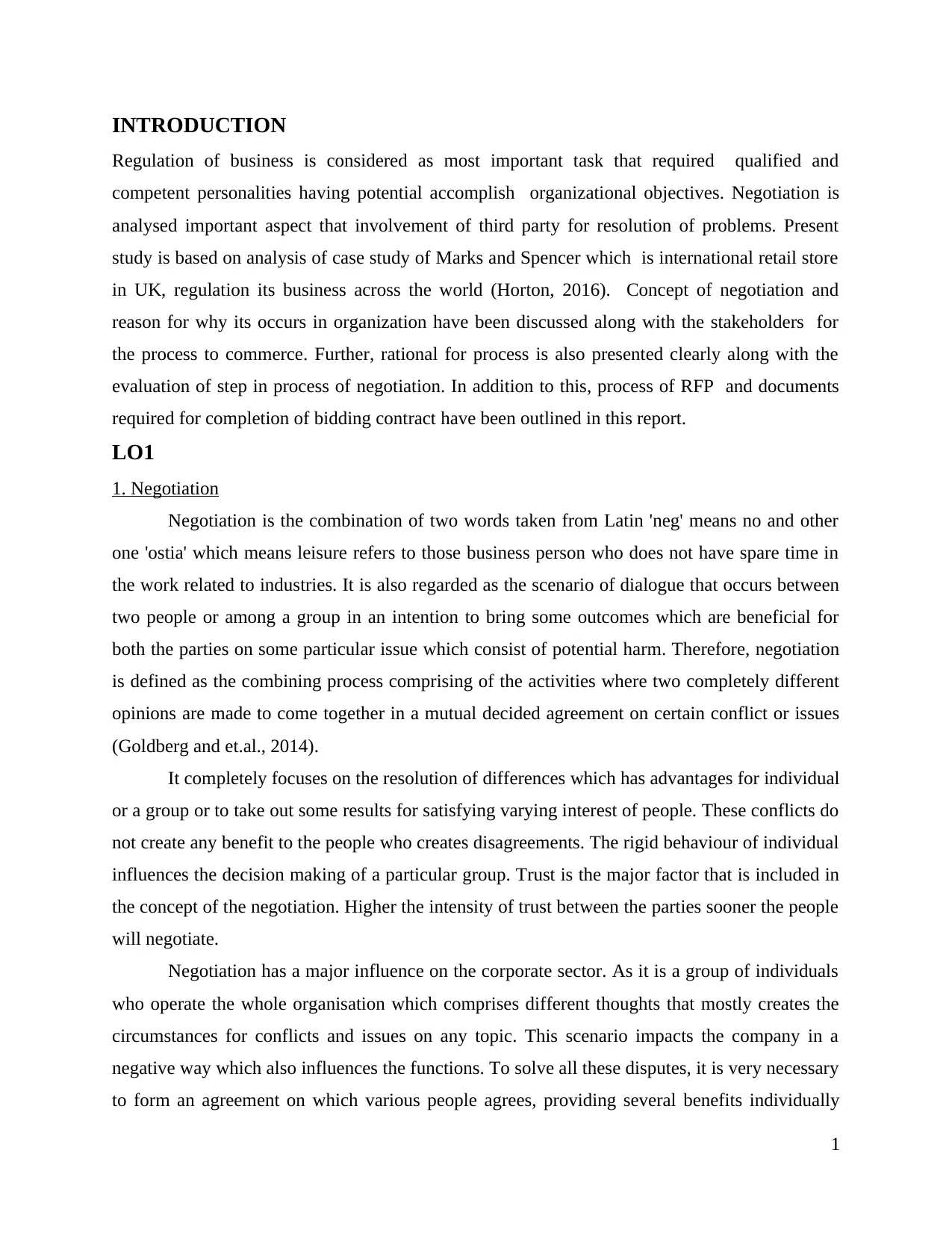
INTRODUCTION
Regulation of business is considered as most important task that required qualified and
competent personalities having potential accomplish organizational objectives. Negotiation is
analysed important aspect that involvement of third party for resolution of problems. Present
study is based on analysis of case study of Marks and Spencer which is international retail store
in UK, regulation its business across the world (Horton, 2016). Concept of negotiation and
reason for why its occurs in organization have been discussed along with the stakeholders for
the process to commerce. Further, rational for process is also presented clearly along with the
evaluation of step in process of negotiation. In addition to this, process of RFP and documents
required for completion of bidding contract have been outlined in this report.
LO1
1. Negotiation
Negotiation is the combination of two words taken from Latin 'neg' means no and other
one 'ostia' which means leisure refers to those business person who does not have spare time in
the work related to industries. It is also regarded as the scenario of dialogue that occurs between
two people or among a group in an intention to bring some outcomes which are beneficial for
both the parties on some particular issue which consist of potential harm. Therefore, negotiation
is defined as the combining process comprising of the activities where two completely different
opinions are made to come together in a mutual decided agreement on certain conflict or issues
(Goldberg and et.al., 2014).
It completely focuses on the resolution of differences which has advantages for individual
or a group or to take out some results for satisfying varying interest of people. These conflicts do
not create any benefit to the people who creates disagreements. The rigid behaviour of individual
influences the decision making of a particular group. Trust is the major factor that is included in
the concept of the negotiation. Higher the intensity of trust between the parties sooner the people
will negotiate.
Negotiation has a major influence on the corporate sector. As it is a group of individuals
who operate the whole organisation which comprises different thoughts that mostly creates the
circumstances for conflicts and issues on any topic. This scenario impacts the company in a
negative way which also influences the functions. To solve all these disputes, it is very necessary
to form an agreement on which various people agrees, providing several benefits individually
1
Regulation of business is considered as most important task that required qualified and
competent personalities having potential accomplish organizational objectives. Negotiation is
analysed important aspect that involvement of third party for resolution of problems. Present
study is based on analysis of case study of Marks and Spencer which is international retail store
in UK, regulation its business across the world (Horton, 2016). Concept of negotiation and
reason for why its occurs in organization have been discussed along with the stakeholders for
the process to commerce. Further, rational for process is also presented clearly along with the
evaluation of step in process of negotiation. In addition to this, process of RFP and documents
required for completion of bidding contract have been outlined in this report.
LO1
1. Negotiation
Negotiation is the combination of two words taken from Latin 'neg' means no and other
one 'ostia' which means leisure refers to those business person who does not have spare time in
the work related to industries. It is also regarded as the scenario of dialogue that occurs between
two people or among a group in an intention to bring some outcomes which are beneficial for
both the parties on some particular issue which consist of potential harm. Therefore, negotiation
is defined as the combining process comprising of the activities where two completely different
opinions are made to come together in a mutual decided agreement on certain conflict or issues
(Goldberg and et.al., 2014).
It completely focuses on the resolution of differences which has advantages for individual
or a group or to take out some results for satisfying varying interest of people. These conflicts do
not create any benefit to the people who creates disagreements. The rigid behaviour of individual
influences the decision making of a particular group. Trust is the major factor that is included in
the concept of the negotiation. Higher the intensity of trust between the parties sooner the people
will negotiate.
Negotiation has a major influence on the corporate sector. As it is a group of individuals
who operate the whole organisation which comprises different thoughts that mostly creates the
circumstances for conflicts and issues on any topic. This scenario impacts the company in a
negative way which also influences the functions. To solve all these disputes, it is very necessary
to form an agreement on which various people agrees, providing several benefits individually
1
⊘ This is a preview!⊘
Do you want full access?
Subscribe today to unlock all pages.

Trusted by 1+ million students worldwide
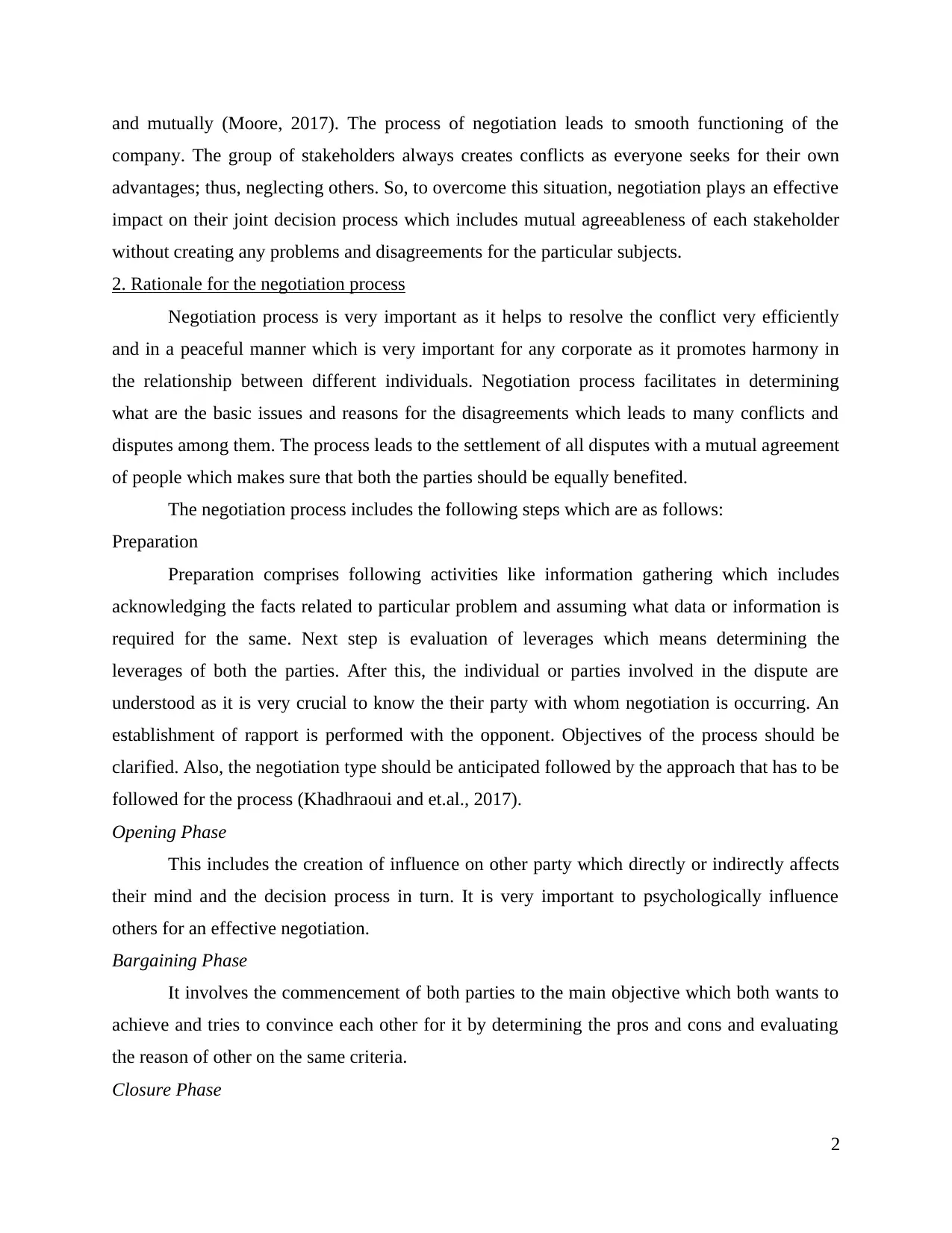
and mutually (Moore, 2017). The process of negotiation leads to smooth functioning of the
company. The group of stakeholders always creates conflicts as everyone seeks for their own
advantages; thus, neglecting others. So, to overcome this situation, negotiation plays an effective
impact on their joint decision process which includes mutual agreeableness of each stakeholder
without creating any problems and disagreements for the particular subjects.
2. Rationale for the negotiation process
Negotiation process is very important as it helps to resolve the conflict very efficiently
and in a peaceful manner which is very important for any corporate as it promotes harmony in
the relationship between different individuals. Negotiation process facilitates in determining
what are the basic issues and reasons for the disagreements which leads to many conflicts and
disputes among them. The process leads to the settlement of all disputes with a mutual agreement
of people which makes sure that both the parties should be equally benefited.
The negotiation process includes the following steps which are as follows:
Preparation
Preparation comprises following activities like information gathering which includes
acknowledging the facts related to particular problem and assuming what data or information is
required for the same. Next step is evaluation of leverages which means determining the
leverages of both the parties. After this, the individual or parties involved in the dispute are
understood as it is very crucial to know the their party with whom negotiation is occurring. An
establishment of rapport is performed with the opponent. Objectives of the process should be
clarified. Also, the negotiation type should be anticipated followed by the approach that has to be
followed for the process (Khadhraoui and et.al., 2017).
Opening Phase
This includes the creation of influence on other party which directly or indirectly affects
their mind and the decision process in turn. It is very important to psychologically influence
others for an effective negotiation.
Bargaining Phase
It involves the commencement of both parties to the main objective which both wants to
achieve and tries to convince each other for it by determining the pros and cons and evaluating
the reason of other on the same criteria.
Closure Phase
2
company. The group of stakeholders always creates conflicts as everyone seeks for their own
advantages; thus, neglecting others. So, to overcome this situation, negotiation plays an effective
impact on their joint decision process which includes mutual agreeableness of each stakeholder
without creating any problems and disagreements for the particular subjects.
2. Rationale for the negotiation process
Negotiation process is very important as it helps to resolve the conflict very efficiently
and in a peaceful manner which is very important for any corporate as it promotes harmony in
the relationship between different individuals. Negotiation process facilitates in determining
what are the basic issues and reasons for the disagreements which leads to many conflicts and
disputes among them. The process leads to the settlement of all disputes with a mutual agreement
of people which makes sure that both the parties should be equally benefited.
The negotiation process includes the following steps which are as follows:
Preparation
Preparation comprises following activities like information gathering which includes
acknowledging the facts related to particular problem and assuming what data or information is
required for the same. Next step is evaluation of leverages which means determining the
leverages of both the parties. After this, the individual or parties involved in the dispute are
understood as it is very crucial to know the their party with whom negotiation is occurring. An
establishment of rapport is performed with the opponent. Objectives of the process should be
clarified. Also, the negotiation type should be anticipated followed by the approach that has to be
followed for the process (Khadhraoui and et.al., 2017).
Opening Phase
This includes the creation of influence on other party which directly or indirectly affects
their mind and the decision process in turn. It is very important to psychologically influence
others for an effective negotiation.
Bargaining Phase
It involves the commencement of both parties to the main objective which both wants to
achieve and tries to convince each other for it by determining the pros and cons and evaluating
the reason of other on the same criteria.
Closure Phase
2
Paraphrase This Document
Need a fresh take? Get an instant paraphrase of this document with our AI Paraphraser
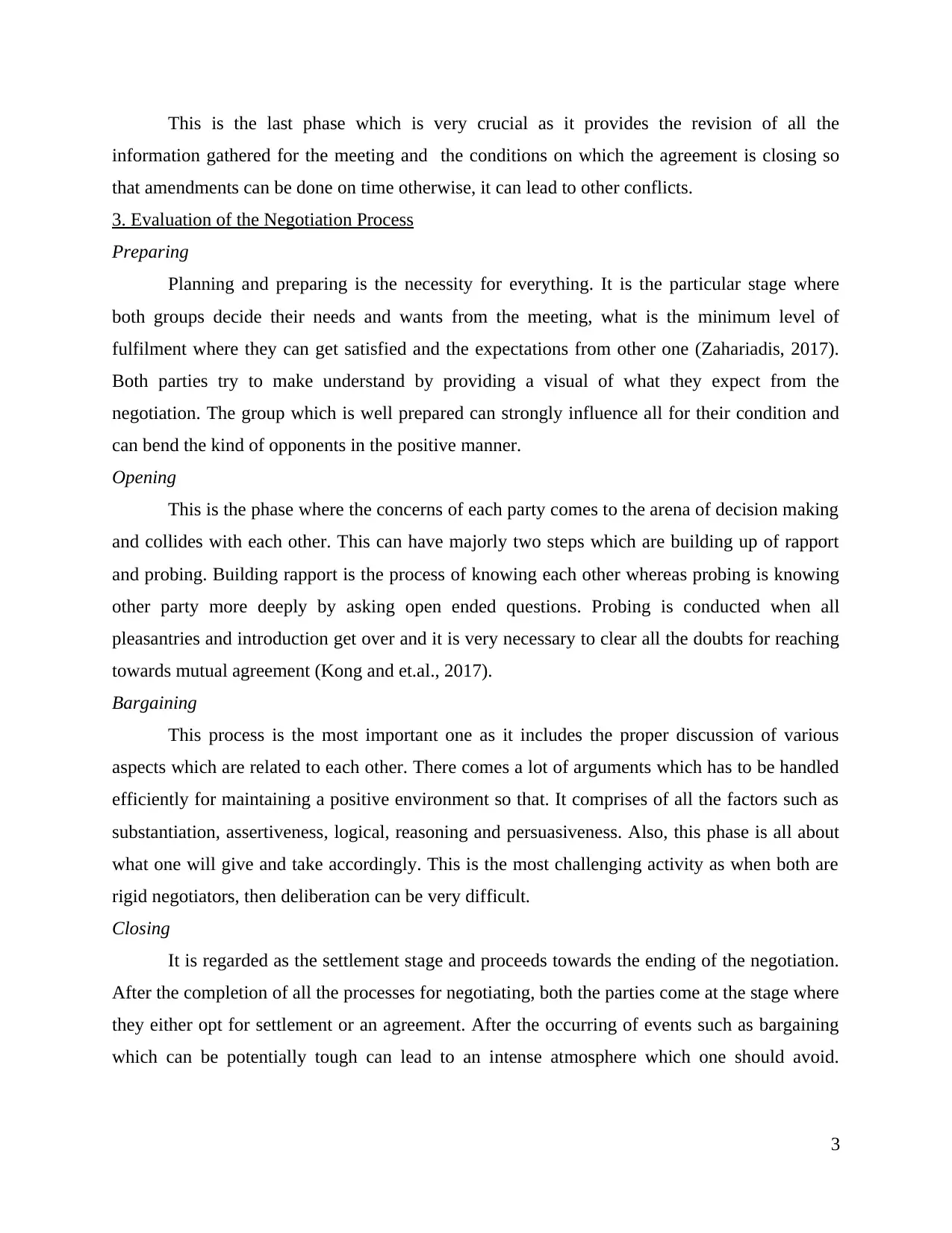
This is the last phase which is very crucial as it provides the revision of all the
information gathered for the meeting and the conditions on which the agreement is closing so
that amendments can be done on time otherwise, it can lead to other conflicts.
3. Evaluation of the Negotiation Process
Preparing
Planning and preparing is the necessity for everything. It is the particular stage where
both groups decide their needs and wants from the meeting, what is the minimum level of
fulfilment where they can get satisfied and the expectations from other one (Zahariadis, 2017).
Both parties try to make understand by providing a visual of what they expect from the
negotiation. The group which is well prepared can strongly influence all for their condition and
can bend the kind of opponents in the positive manner.
Opening
This is the phase where the concerns of each party comes to the arena of decision making
and collides with each other. This can have majorly two steps which are building up of rapport
and probing. Building rapport is the process of knowing each other whereas probing is knowing
other party more deeply by asking open ended questions. Probing is conducted when all
pleasantries and introduction get over and it is very necessary to clear all the doubts for reaching
towards mutual agreement (Kong and et.al., 2017).
Bargaining
This process is the most important one as it includes the proper discussion of various
aspects which are related to each other. There comes a lot of arguments which has to be handled
efficiently for maintaining a positive environment so that. It comprises of all the factors such as
substantiation, assertiveness, logical, reasoning and persuasiveness. Also, this phase is all about
what one will give and take accordingly. This is the most challenging activity as when both are
rigid negotiators, then deliberation can be very difficult.
Closing
It is regarded as the settlement stage and proceeds towards the ending of the negotiation.
After the completion of all the processes for negotiating, both the parties come at the stage where
they either opt for settlement or an agreement. After the occurring of events such as bargaining
which can be potentially tough can lead to an intense atmosphere which one should avoid.
3
information gathered for the meeting and the conditions on which the agreement is closing so
that amendments can be done on time otherwise, it can lead to other conflicts.
3. Evaluation of the Negotiation Process
Preparing
Planning and preparing is the necessity for everything. It is the particular stage where
both groups decide their needs and wants from the meeting, what is the minimum level of
fulfilment where they can get satisfied and the expectations from other one (Zahariadis, 2017).
Both parties try to make understand by providing a visual of what they expect from the
negotiation. The group which is well prepared can strongly influence all for their condition and
can bend the kind of opponents in the positive manner.
Opening
This is the phase where the concerns of each party comes to the arena of decision making
and collides with each other. This can have majorly two steps which are building up of rapport
and probing. Building rapport is the process of knowing each other whereas probing is knowing
other party more deeply by asking open ended questions. Probing is conducted when all
pleasantries and introduction get over and it is very necessary to clear all the doubts for reaching
towards mutual agreement (Kong and et.al., 2017).
Bargaining
This process is the most important one as it includes the proper discussion of various
aspects which are related to each other. There comes a lot of arguments which has to be handled
efficiently for maintaining a positive environment so that. It comprises of all the factors such as
substantiation, assertiveness, logical, reasoning and persuasiveness. Also, this phase is all about
what one will give and take accordingly. This is the most challenging activity as when both are
rigid negotiators, then deliberation can be very difficult.
Closing
It is regarded as the settlement stage and proceeds towards the ending of the negotiation.
After the completion of all the processes for negotiating, both the parties come at the stage where
they either opt for settlement or an agreement. After the occurring of events such as bargaining
which can be potentially tough can lead to an intense atmosphere which one should avoid.
3
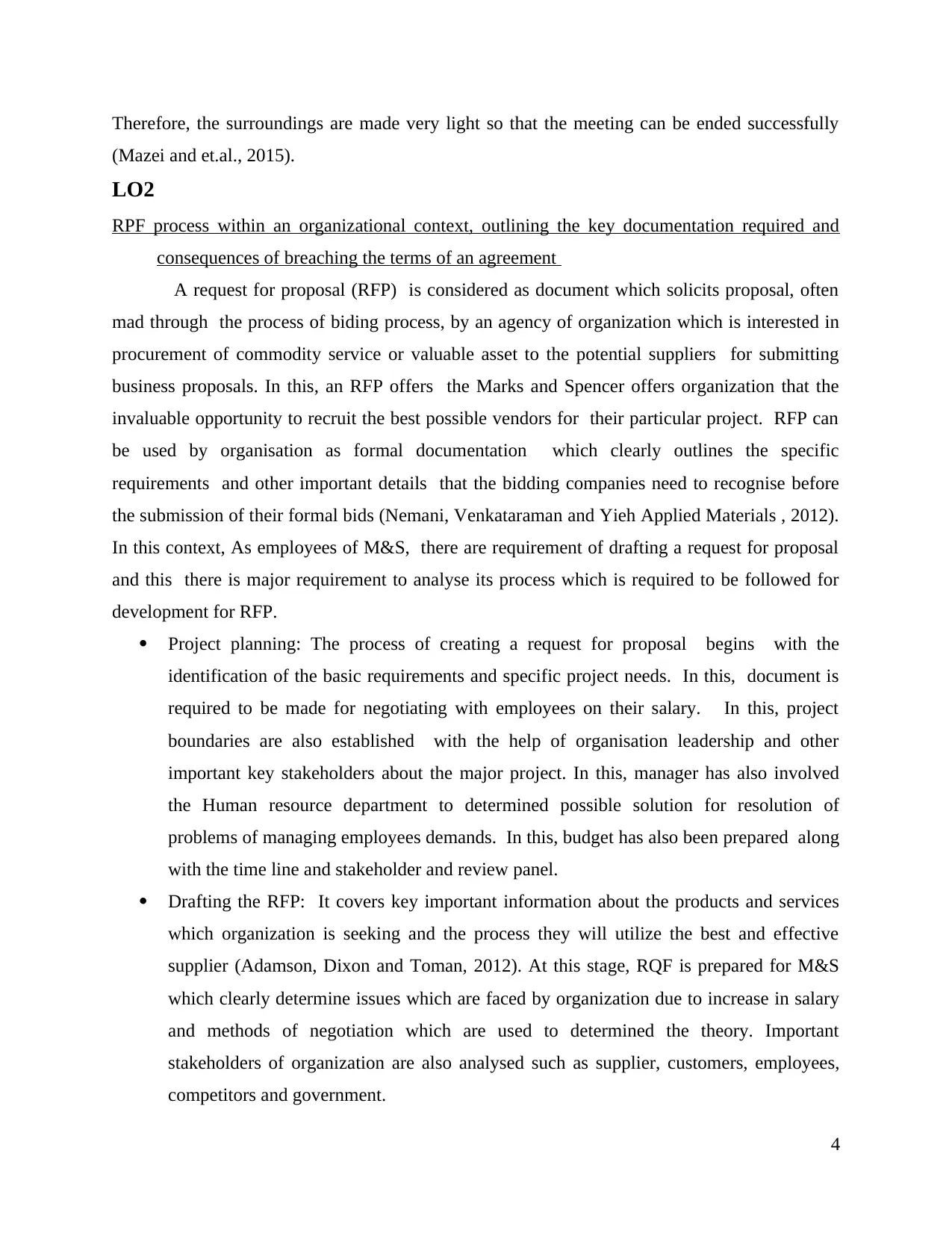
Therefore, the surroundings are made very light so that the meeting can be ended successfully
(Mazei and et.al., 2015).
LO2
RPF process within an organizational context, outlining the key documentation required and
consequences of breaching the terms of an agreement
A request for proposal (RFP) is considered as document which solicits proposal, often
mad through the process of biding process, by an agency of organization which is interested in
procurement of commodity service or valuable asset to the potential suppliers for submitting
business proposals. In this, an RFP offers the Marks and Spencer offers organization that the
invaluable opportunity to recruit the best possible vendors for their particular project. RFP can
be used by organisation as formal documentation which clearly outlines the specific
requirements and other important details that the bidding companies need to recognise before
the submission of their formal bids (Nemani, Venkataraman and Yieh Applied Materials , 2012).
In this context, As employees of M&S, there are requirement of drafting a request for proposal
and this there is major requirement to analyse its process which is required to be followed for
development for RFP.
Project planning: The process of creating a request for proposal begins with the
identification of the basic requirements and specific project needs. In this, document is
required to be made for negotiating with employees on their salary. In this, project
boundaries are also established with the help of organisation leadership and other
important key stakeholders about the major project. In this, manager has also involved
the Human resource department to determined possible solution for resolution of
problems of managing employees demands. In this, budget has also been prepared along
with the time line and stakeholder and review panel.
Drafting the RFP: It covers key important information about the products and services
which organization is seeking and the process they will utilize the best and effective
supplier (Adamson, Dixon and Toman, 2012). At this stage, RQF is prepared for M&S
which clearly determine issues which are faced by organization due to increase in salary
and methods of negotiation which are used to determined the theory. Important
stakeholders of organization are also analysed such as supplier, customers, employees,
competitors and government.
4
(Mazei and et.al., 2015).
LO2
RPF process within an organizational context, outlining the key documentation required and
consequences of breaching the terms of an agreement
A request for proposal (RFP) is considered as document which solicits proposal, often
mad through the process of biding process, by an agency of organization which is interested in
procurement of commodity service or valuable asset to the potential suppliers for submitting
business proposals. In this, an RFP offers the Marks and Spencer offers organization that the
invaluable opportunity to recruit the best possible vendors for their particular project. RFP can
be used by organisation as formal documentation which clearly outlines the specific
requirements and other important details that the bidding companies need to recognise before
the submission of their formal bids (Nemani, Venkataraman and Yieh Applied Materials , 2012).
In this context, As employees of M&S, there are requirement of drafting a request for proposal
and this there is major requirement to analyse its process which is required to be followed for
development for RFP.
Project planning: The process of creating a request for proposal begins with the
identification of the basic requirements and specific project needs. In this, document is
required to be made for negotiating with employees on their salary. In this, project
boundaries are also established with the help of organisation leadership and other
important key stakeholders about the major project. In this, manager has also involved
the Human resource department to determined possible solution for resolution of
problems of managing employees demands. In this, budget has also been prepared along
with the time line and stakeholder and review panel.
Drafting the RFP: It covers key important information about the products and services
which organization is seeking and the process they will utilize the best and effective
supplier (Adamson, Dixon and Toman, 2012). At this stage, RQF is prepared for M&S
which clearly determine issues which are faced by organization due to increase in salary
and methods of negotiation which are used to determined the theory. Important
stakeholders of organization are also analysed such as supplier, customers, employees,
competitors and government.
4
⊘ This is a preview!⊘
Do you want full access?
Subscribe today to unlock all pages.

Trusted by 1+ million students worldwide
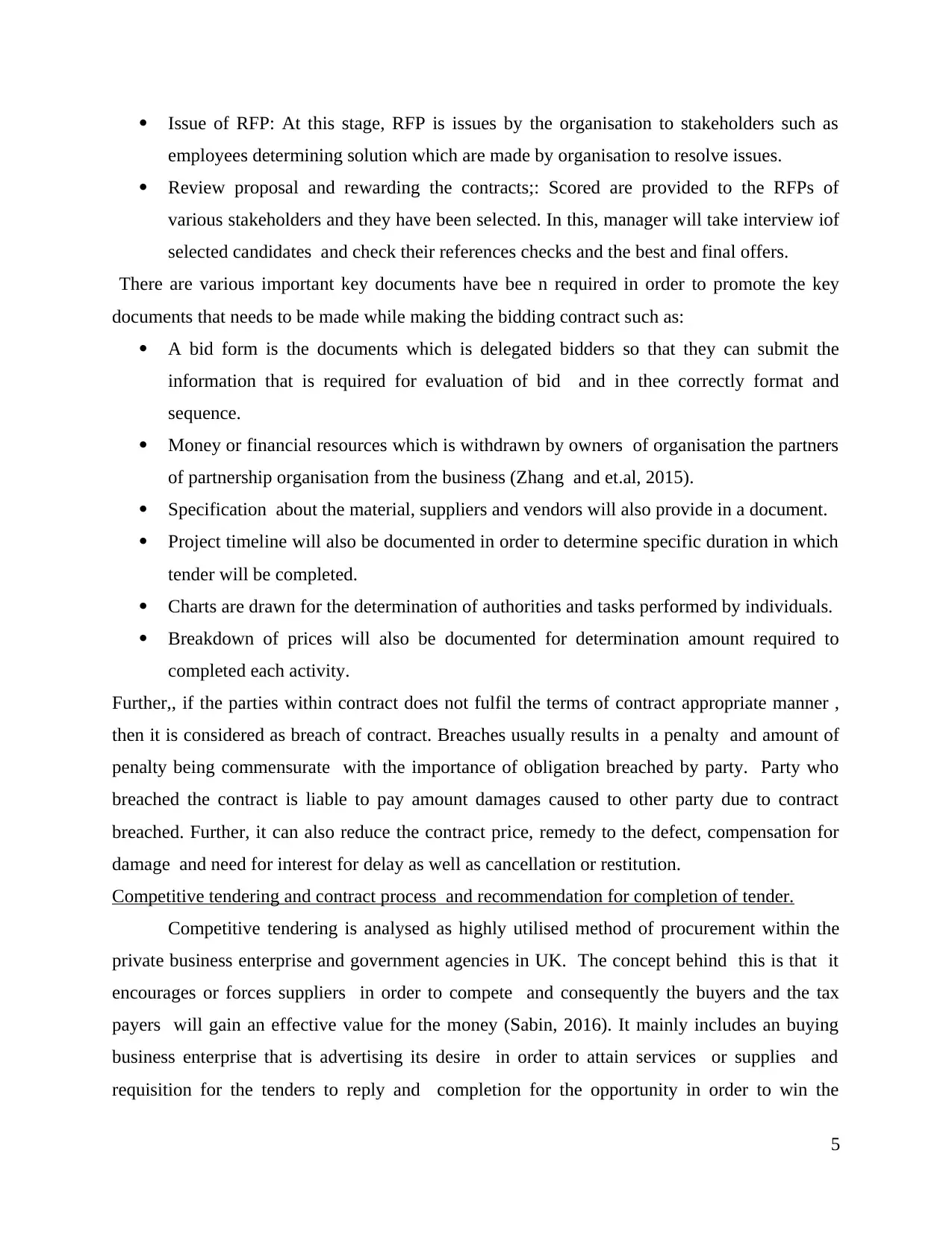
Issue of RFP: At this stage, RFP is issues by the organisation to stakeholders such as
employees determining solution which are made by organisation to resolve issues.
Review proposal and rewarding the contracts;: Scored are provided to the RFPs of
various stakeholders and they have been selected. In this, manager will take interview iof
selected candidates and check their references checks and the best and final offers.
There are various important key documents have bee n required in order to promote the key
documents that needs to be made while making the bidding contract such as:
A bid form is the documents which is delegated bidders so that they can submit the
information that is required for evaluation of bid and in thee correctly format and
sequence.
Money or financial resources which is withdrawn by owners of organisation the partners
of partnership organisation from the business (Zhang and et.al, 2015).
Specification about the material, suppliers and vendors will also provide in a document.
Project timeline will also be documented in order to determine specific duration in which
tender will be completed.
Charts are drawn for the determination of authorities and tasks performed by individuals.
Breakdown of prices will also be documented for determination amount required to
completed each activity.
Further,, if the parties within contract does not fulfil the terms of contract appropriate manner ,
then it is considered as breach of contract. Breaches usually results in a penalty and amount of
penalty being commensurate with the importance of obligation breached by party. Party who
breached the contract is liable to pay amount damages caused to other party due to contract
breached. Further, it can also reduce the contract price, remedy to the defect, compensation for
damage and need for interest for delay as well as cancellation or restitution.
Competitive tendering and contract process and recommendation for completion of tender.
Competitive tendering is analysed as highly utilised method of procurement within the
private business enterprise and government agencies in UK. The concept behind this is that it
encourages or forces suppliers in order to compete and consequently the buyers and the tax
payers will gain an effective value for the money (Sabin, 2016). It mainly includes an buying
business enterprise that is advertising its desire in order to attain services or supplies and
requisition for the tenders to reply and completion for the opportunity in order to win the
5
employees determining solution which are made by organisation to resolve issues.
Review proposal and rewarding the contracts;: Scored are provided to the RFPs of
various stakeholders and they have been selected. In this, manager will take interview iof
selected candidates and check their references checks and the best and final offers.
There are various important key documents have bee n required in order to promote the key
documents that needs to be made while making the bidding contract such as:
A bid form is the documents which is delegated bidders so that they can submit the
information that is required for evaluation of bid and in thee correctly format and
sequence.
Money or financial resources which is withdrawn by owners of organisation the partners
of partnership organisation from the business (Zhang and et.al, 2015).
Specification about the material, suppliers and vendors will also provide in a document.
Project timeline will also be documented in order to determine specific duration in which
tender will be completed.
Charts are drawn for the determination of authorities and tasks performed by individuals.
Breakdown of prices will also be documented for determination amount required to
completed each activity.
Further,, if the parties within contract does not fulfil the terms of contract appropriate manner ,
then it is considered as breach of contract. Breaches usually results in a penalty and amount of
penalty being commensurate with the importance of obligation breached by party. Party who
breached the contract is liable to pay amount damages caused to other party due to contract
breached. Further, it can also reduce the contract price, remedy to the defect, compensation for
damage and need for interest for delay as well as cancellation or restitution.
Competitive tendering and contract process and recommendation for completion of tender.
Competitive tendering is analysed as highly utilised method of procurement within the
private business enterprise and government agencies in UK. The concept behind this is that it
encourages or forces suppliers in order to compete and consequently the buyers and the tax
payers will gain an effective value for the money (Sabin, 2016). It mainly includes an buying
business enterprise that is advertising its desire in order to attain services or supplies and
requisition for the tenders to reply and completion for the opportunity in order to win the
5
Paraphrase This Document
Need a fresh take? Get an instant paraphrase of this document with our AI Paraphraser
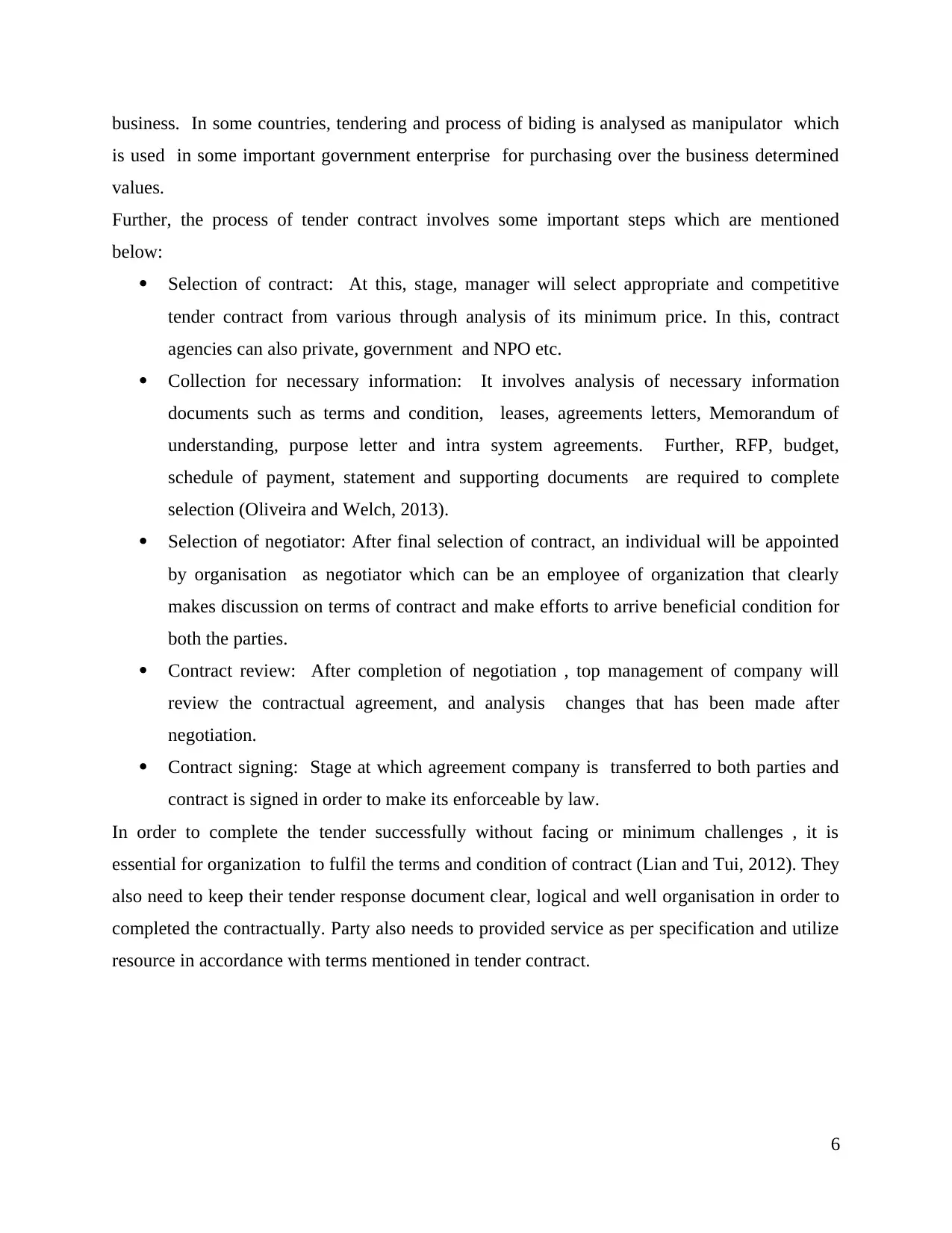
business. In some countries, tendering and process of biding is analysed as manipulator which
is used in some important government enterprise for purchasing over the business determined
values.
Further, the process of tender contract involves some important steps which are mentioned
below:
Selection of contract: At this, stage, manager will select appropriate and competitive
tender contract from various through analysis of its minimum price. In this, contract
agencies can also private, government and NPO etc.
Collection for necessary information: It involves analysis of necessary information
documents such as terms and condition, leases, agreements letters, Memorandum of
understanding, purpose letter and intra system agreements. Further, RFP, budget,
schedule of payment, statement and supporting documents are required to complete
selection (Oliveira and Welch, 2013).
Selection of negotiator: After final selection of contract, an individual will be appointed
by organisation as negotiator which can be an employee of organization that clearly
makes discussion on terms of contract and make efforts to arrive beneficial condition for
both the parties.
Contract review: After completion of negotiation , top management of company will
review the contractual agreement, and analysis changes that has been made after
negotiation.
Contract signing: Stage at which agreement company is transferred to both parties and
contract is signed in order to make its enforceable by law.
In order to complete the tender successfully without facing or minimum challenges , it is
essential for organization to fulfil the terms and condition of contract (Lian and Tui, 2012). They
also need to keep their tender response document clear, logical and well organisation in order to
completed the contractually. Party also needs to provided service as per specification and utilize
resource in accordance with terms mentioned in tender contract.
6
is used in some important government enterprise for purchasing over the business determined
values.
Further, the process of tender contract involves some important steps which are mentioned
below:
Selection of contract: At this, stage, manager will select appropriate and competitive
tender contract from various through analysis of its minimum price. In this, contract
agencies can also private, government and NPO etc.
Collection for necessary information: It involves analysis of necessary information
documents such as terms and condition, leases, agreements letters, Memorandum of
understanding, purpose letter and intra system agreements. Further, RFP, budget,
schedule of payment, statement and supporting documents are required to complete
selection (Oliveira and Welch, 2013).
Selection of negotiator: After final selection of contract, an individual will be appointed
by organisation as negotiator which can be an employee of organization that clearly
makes discussion on terms of contract and make efforts to arrive beneficial condition for
both the parties.
Contract review: After completion of negotiation , top management of company will
review the contractual agreement, and analysis changes that has been made after
negotiation.
Contract signing: Stage at which agreement company is transferred to both parties and
contract is signed in order to make its enforceable by law.
In order to complete the tender successfully without facing or minimum challenges , it is
essential for organization to fulfil the terms and condition of contract (Lian and Tui, 2012). They
also need to keep their tender response document clear, logical and well organisation in order to
completed the contractually. Party also needs to provided service as per specification and utilize
resource in accordance with terms mentioned in tender contract.
6
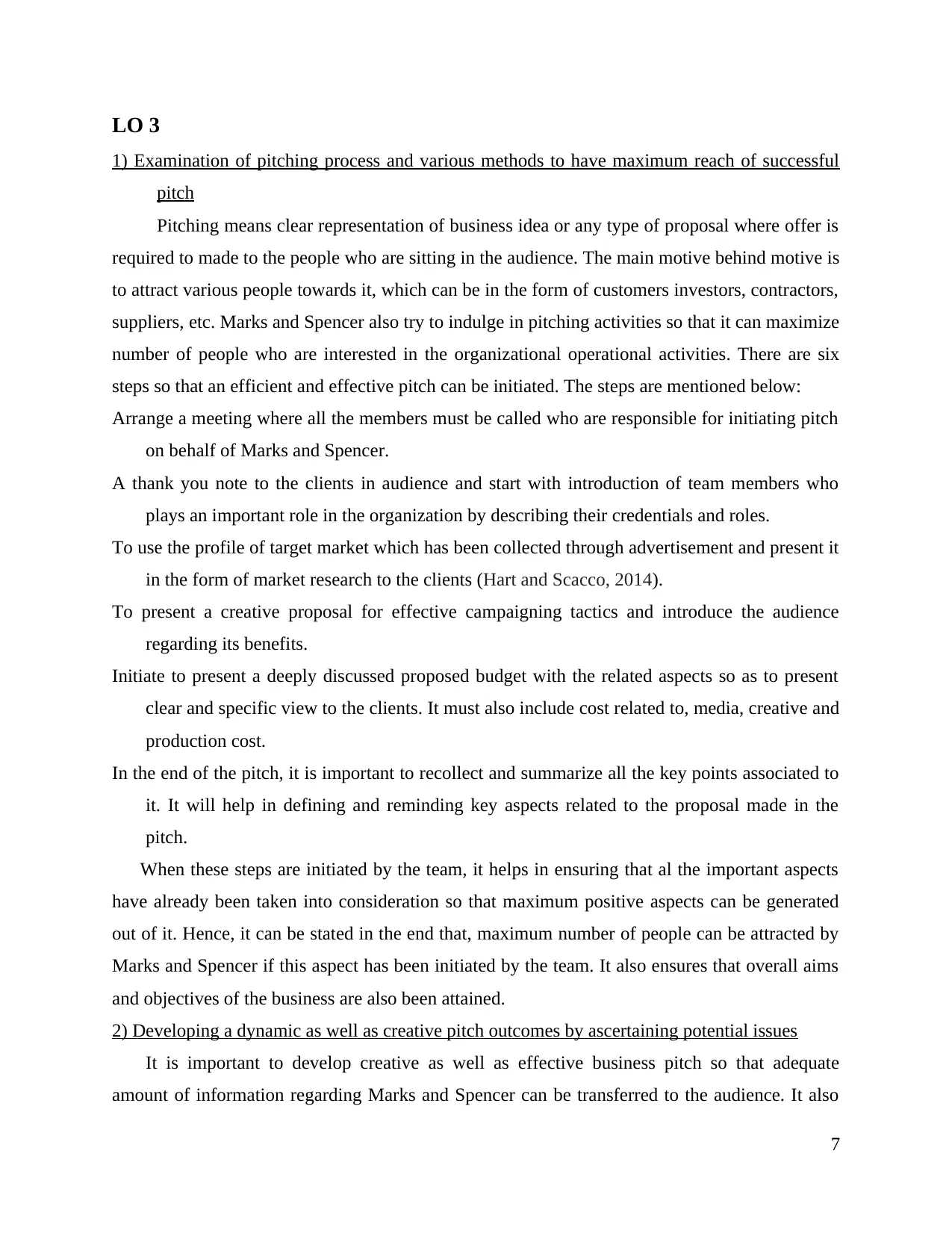
LO 3
1) Examination of pitching process and various methods to have maximum reach of successful
pitch
Pitching means clear representation of business idea or any type of proposal where offer is
required to made to the people who are sitting in the audience. The main motive behind motive is
to attract various people towards it, which can be in the form of customers investors, contractors,
suppliers, etc. Marks and Spencer also try to indulge in pitching activities so that it can maximize
number of people who are interested in the organizational operational activities. There are six
steps so that an efficient and effective pitch can be initiated. The steps are mentioned below:
Arrange a meeting where all the members must be called who are responsible for initiating pitch
on behalf of Marks and Spencer.
A thank you note to the clients in audience and start with introduction of team members who
plays an important role in the organization by describing their credentials and roles.
To use the profile of target market which has been collected through advertisement and present it
in the form of market research to the clients (Hart and Scacco, 2014).
To present a creative proposal for effective campaigning tactics and introduce the audience
regarding its benefits.
Initiate to present a deeply discussed proposed budget with the related aspects so as to present
clear and specific view to the clients. It must also include cost related to, media, creative and
production cost.
In the end of the pitch, it is important to recollect and summarize all the key points associated to
it. It will help in defining and reminding key aspects related to the proposal made in the
pitch.
When these steps are initiated by the team, it helps in ensuring that al the important aspects
have already been taken into consideration so that maximum positive aspects can be generated
out of it. Hence, it can be stated in the end that, maximum number of people can be attracted by
Marks and Spencer if this aspect has been initiated by the team. It also ensures that overall aims
and objectives of the business are also been attained.
2) Developing a dynamic as well as creative pitch outcomes by ascertaining potential issues
It is important to develop creative as well as effective business pitch so that adequate
amount of information regarding Marks and Spencer can be transferred to the audience. It also
7
1) Examination of pitching process and various methods to have maximum reach of successful
pitch
Pitching means clear representation of business idea or any type of proposal where offer is
required to made to the people who are sitting in the audience. The main motive behind motive is
to attract various people towards it, which can be in the form of customers investors, contractors,
suppliers, etc. Marks and Spencer also try to indulge in pitching activities so that it can maximize
number of people who are interested in the organizational operational activities. There are six
steps so that an efficient and effective pitch can be initiated. The steps are mentioned below:
Arrange a meeting where all the members must be called who are responsible for initiating pitch
on behalf of Marks and Spencer.
A thank you note to the clients in audience and start with introduction of team members who
plays an important role in the organization by describing their credentials and roles.
To use the profile of target market which has been collected through advertisement and present it
in the form of market research to the clients (Hart and Scacco, 2014).
To present a creative proposal for effective campaigning tactics and introduce the audience
regarding its benefits.
Initiate to present a deeply discussed proposed budget with the related aspects so as to present
clear and specific view to the clients. It must also include cost related to, media, creative and
production cost.
In the end of the pitch, it is important to recollect and summarize all the key points associated to
it. It will help in defining and reminding key aspects related to the proposal made in the
pitch.
When these steps are initiated by the team, it helps in ensuring that al the important aspects
have already been taken into consideration so that maximum positive aspects can be generated
out of it. Hence, it can be stated in the end that, maximum number of people can be attracted by
Marks and Spencer if this aspect has been initiated by the team. It also ensures that overall aims
and objectives of the business are also been attained.
2) Developing a dynamic as well as creative pitch outcomes by ascertaining potential issues
It is important to develop creative as well as effective business pitch so that adequate
amount of information regarding Marks and Spencer can be transferred to the audience. It also
7
⊘ This is a preview!⊘
Do you want full access?
Subscribe today to unlock all pages.

Trusted by 1+ million students worldwide
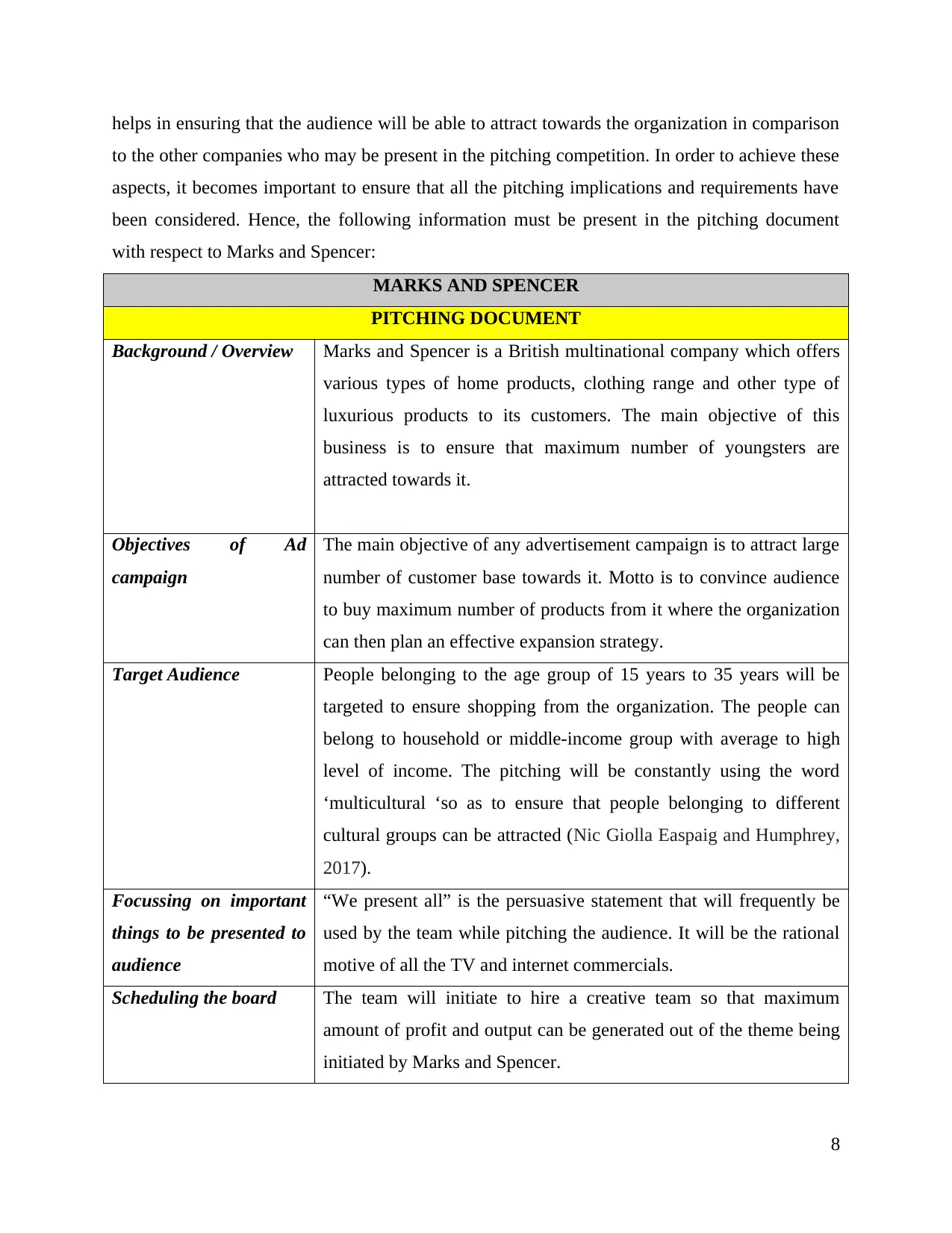
helps in ensuring that the audience will be able to attract towards the organization in comparison
to the other companies who may be present in the pitching competition. In order to achieve these
aspects, it becomes important to ensure that all the pitching implications and requirements have
been considered. Hence, the following information must be present in the pitching document
with respect to Marks and Spencer:
MARKS AND SPENCER
PITCHING DOCUMENT
Background / Overview Marks and Spencer is a British multinational company which offers
various types of home products, clothing range and other type of
luxurious products to its customers. The main objective of this
business is to ensure that maximum number of youngsters are
attracted towards it.
Objectives of Ad
campaign
The main objective of any advertisement campaign is to attract large
number of customer base towards it. Motto is to convince audience
to buy maximum number of products from it where the organization
can then plan an effective expansion strategy.
Target Audience People belonging to the age group of 15 years to 35 years will be
targeted to ensure shopping from the organization. The people can
belong to household or middle-income group with average to high
level of income. The pitching will be constantly using the word
‘multicultural ‘so as to ensure that people belonging to different
cultural groups can be attracted (Nic Giolla Easpaig and Humphrey,
2017).
Focussing on important
things to be presented to
audience
“We present all” is the persuasive statement that will frequently be
used by the team while pitching the audience. It will be the rational
motive of all the TV and internet commercials.
Scheduling the board The team will initiate to hire a creative team so that maximum
amount of profit and output can be generated out of the theme being
initiated by Marks and Spencer.
8
to the other companies who may be present in the pitching competition. In order to achieve these
aspects, it becomes important to ensure that all the pitching implications and requirements have
been considered. Hence, the following information must be present in the pitching document
with respect to Marks and Spencer:
MARKS AND SPENCER
PITCHING DOCUMENT
Background / Overview Marks and Spencer is a British multinational company which offers
various types of home products, clothing range and other type of
luxurious products to its customers. The main objective of this
business is to ensure that maximum number of youngsters are
attracted towards it.
Objectives of Ad
campaign
The main objective of any advertisement campaign is to attract large
number of customer base towards it. Motto is to convince audience
to buy maximum number of products from it where the organization
can then plan an effective expansion strategy.
Target Audience People belonging to the age group of 15 years to 35 years will be
targeted to ensure shopping from the organization. The people can
belong to household or middle-income group with average to high
level of income. The pitching will be constantly using the word
‘multicultural ‘so as to ensure that people belonging to different
cultural groups can be attracted (Nic Giolla Easpaig and Humphrey,
2017).
Focussing on important
things to be presented to
audience
“We present all” is the persuasive statement that will frequently be
used by the team while pitching the audience. It will be the rational
motive of all the TV and internet commercials.
Scheduling the board The team will initiate to hire a creative team so that maximum
amount of profit and output can be generated out of the theme being
initiated by Marks and Spencer.
8
Paraphrase This Document
Need a fresh take? Get an instant paraphrase of this document with our AI Paraphraser
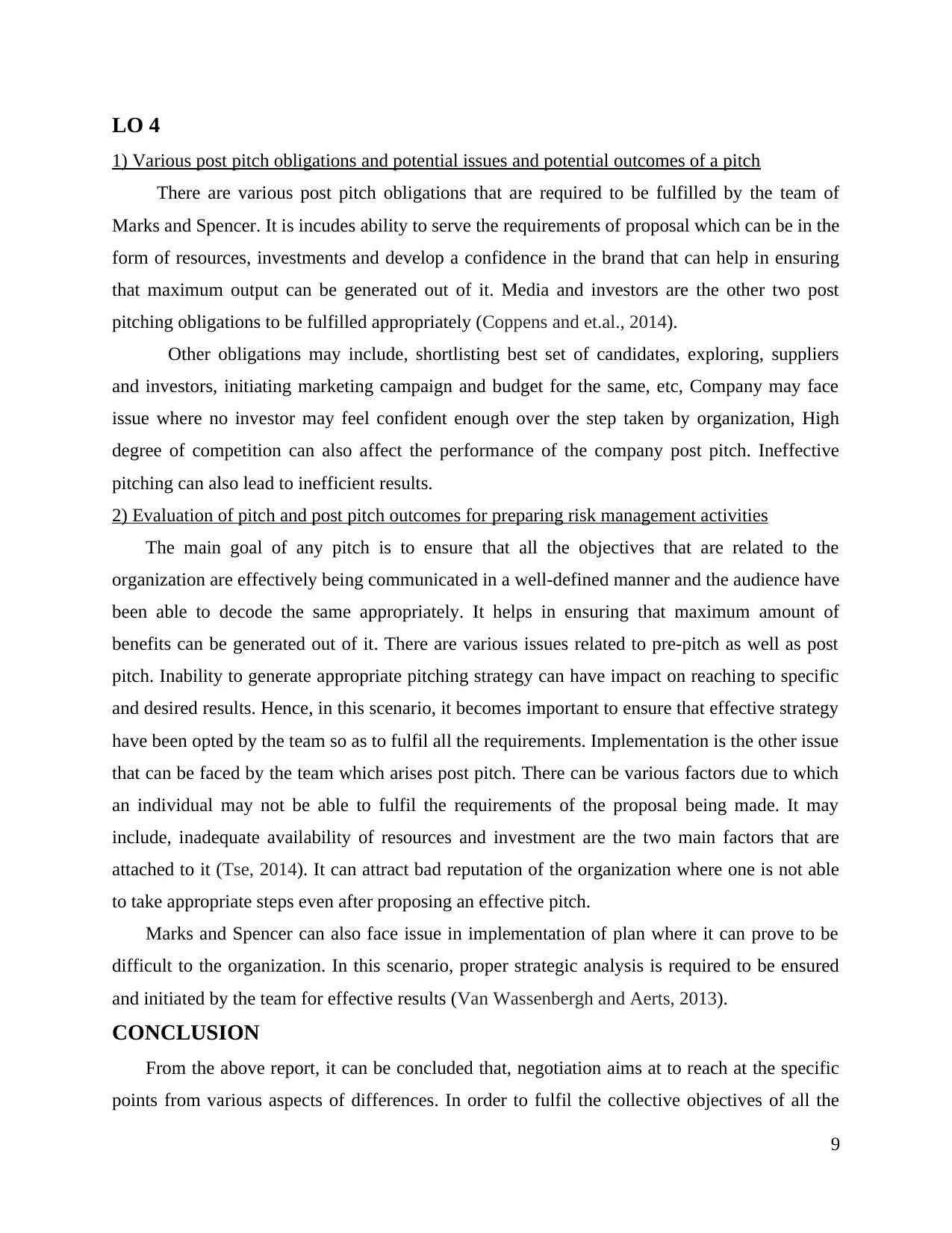
LO 4
1) Various post pitch obligations and potential issues and potential outcomes of a pitch
There are various post pitch obligations that are required to be fulfilled by the team of
Marks and Spencer. It is incudes ability to serve the requirements of proposal which can be in the
form of resources, investments and develop a confidence in the brand that can help in ensuring
that maximum output can be generated out of it. Media and investors are the other two post
pitching obligations to be fulfilled appropriately (Coppens and et.al., 2014).
Other obligations may include, shortlisting best set of candidates, exploring, suppliers
and investors, initiating marketing campaign and budget for the same, etc, Company may face
issue where no investor may feel confident enough over the step taken by organization, High
degree of competition can also affect the performance of the company post pitch. Ineffective
pitching can also lead to inefficient results.
2) Evaluation of pitch and post pitch outcomes for preparing risk management activities
The main goal of any pitch is to ensure that all the objectives that are related to the
organization are effectively being communicated in a well-defined manner and the audience have
been able to decode the same appropriately. It helps in ensuring that maximum amount of
benefits can be generated out of it. There are various issues related to pre-pitch as well as post
pitch. Inability to generate appropriate pitching strategy can have impact on reaching to specific
and desired results. Hence, in this scenario, it becomes important to ensure that effective strategy
have been opted by the team so as to fulfil all the requirements. Implementation is the other issue
that can be faced by the team which arises post pitch. There can be various factors due to which
an individual may not be able to fulfil the requirements of the proposal being made. It may
include, inadequate availability of resources and investment are the two main factors that are
attached to it (Tse, 2014). It can attract bad reputation of the organization where one is not able
to take appropriate steps even after proposing an effective pitch.
Marks and Spencer can also face issue in implementation of plan where it can prove to be
difficult to the organization. In this scenario, proper strategic analysis is required to be ensured
and initiated by the team for effective results (Van Wassenbergh and Aerts, 2013).
CONCLUSION
From the above report, it can be concluded that, negotiation aims at to reach at the specific
points from various aspects of differences. In order to fulfil the collective objectives of all the
9
1) Various post pitch obligations and potential issues and potential outcomes of a pitch
There are various post pitch obligations that are required to be fulfilled by the team of
Marks and Spencer. It is incudes ability to serve the requirements of proposal which can be in the
form of resources, investments and develop a confidence in the brand that can help in ensuring
that maximum output can be generated out of it. Media and investors are the other two post
pitching obligations to be fulfilled appropriately (Coppens and et.al., 2014).
Other obligations may include, shortlisting best set of candidates, exploring, suppliers
and investors, initiating marketing campaign and budget for the same, etc, Company may face
issue where no investor may feel confident enough over the step taken by organization, High
degree of competition can also affect the performance of the company post pitch. Ineffective
pitching can also lead to inefficient results.
2) Evaluation of pitch and post pitch outcomes for preparing risk management activities
The main goal of any pitch is to ensure that all the objectives that are related to the
organization are effectively being communicated in a well-defined manner and the audience have
been able to decode the same appropriately. It helps in ensuring that maximum amount of
benefits can be generated out of it. There are various issues related to pre-pitch as well as post
pitch. Inability to generate appropriate pitching strategy can have impact on reaching to specific
and desired results. Hence, in this scenario, it becomes important to ensure that effective strategy
have been opted by the team so as to fulfil all the requirements. Implementation is the other issue
that can be faced by the team which arises post pitch. There can be various factors due to which
an individual may not be able to fulfil the requirements of the proposal being made. It may
include, inadequate availability of resources and investment are the two main factors that are
attached to it (Tse, 2014). It can attract bad reputation of the organization where one is not able
to take appropriate steps even after proposing an effective pitch.
Marks and Spencer can also face issue in implementation of plan where it can prove to be
difficult to the organization. In this scenario, proper strategic analysis is required to be ensured
and initiated by the team for effective results (Van Wassenbergh and Aerts, 2013).
CONCLUSION
From the above report, it can be concluded that, negotiation aims at to reach at the specific
points from various aspects of differences. In order to fulfil the collective objectives of all the
9

parties being involved in the process. Pitching refers to the presentation of ideas in order to
attract maximum number of people towards it in the form of suppliers, contractors and investors.
10
attract maximum number of people towards it in the form of suppliers, contractors and investors.
10
⊘ This is a preview!⊘
Do you want full access?
Subscribe today to unlock all pages.

Trusted by 1+ million students worldwide
1 out of 15
Related Documents
Your All-in-One AI-Powered Toolkit for Academic Success.
+13062052269
info@desklib.com
Available 24*7 on WhatsApp / Email
![[object Object]](/_next/static/media/star-bottom.7253800d.svg)
Unlock your academic potential
Copyright © 2020–2025 A2Z Services. All Rights Reserved. Developed and managed by ZUCOL.



